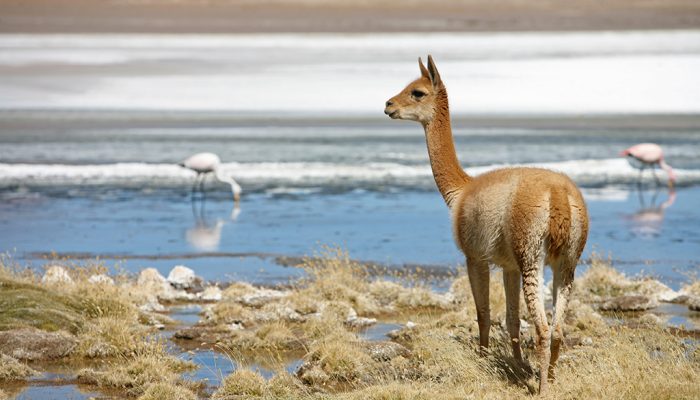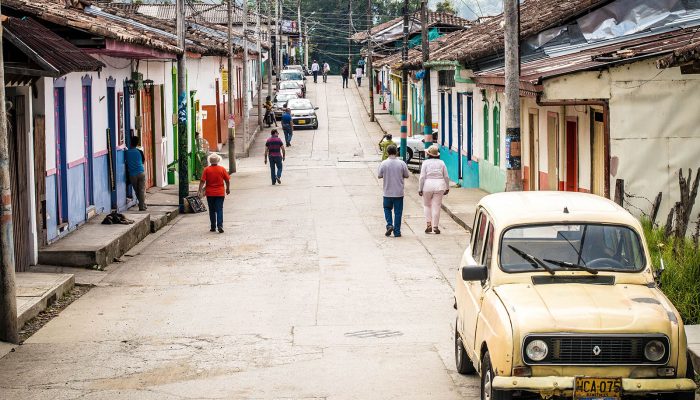Bolivian fauna
In altitude, there are few mammals, you will find mostly camels and their predators! The birds are also limited to a few species of which the most representative are detailed below. The English name (if it exists) is followed by the local name (in italics) and the scientific name (in italics and brackets).
Mammals
White Lama or llama (Lama glama) : the largest Andean camelids and animal par excellence. He lives in the highlands and mountains, up to 4200 meters, being satisfied with sparse vegetation. It was domesticated about 2000 years BC for its wool and meat. It is also used as a pack animal even if the load it supports is limited to 20 kg. Its wither height does not exceed 1.2 meters to a maximum weight of 155 kg. His coat, usually monochrome, varies from pure white to more or less dark brown. Its fur is long and woolly, short tail and ears are long and rounded. It emits various and varied sounds to express feelings or to warn his fellow against danger. In case of aggression, he spits! The llama is a revered animal in Andean culture. The Aymara and Quechua used it in their rituals. Today, it still serves as an offering, especially to the Pachamama (Mother Earth and goddess of fertility).
Alpaca (Vicugna pacos) : domestic mammal of the camelid family. Very sociable, he lives in herds in the mountains, up to 4800 meters. The herds are generally composed of a dominant male accompanied by females with their young. Other males gather apart. Smaller than the llama (0.85 m at the withers on average), it looks like a large sheep (70-80 kg) with a long neck. However, its wool brown colors, black or white is much better than the sheep. It is softer, warmer, stronger and lighter. Above all, it is made of a very fine fiber (between 12 and 32 microns) and high end (one of the most luxurious in the world). Depending on the nature of the coat, we distinguish easily soured, with long hair and drooping of Huacayo at shorter and curly hair. The alpaca is a herbivore ruminant consumes 1.5 to 2 kg of grass a day. He lives an average of twenty years.
Vicuna (Vicugna vicugna) : with its size not exceeding 1 meter and weight between 40 and 60 kg, the vicuna is the smallest camelid. Its long neck supports a muzzle end that hides long sharp incisors continued growth. His upper lip split into two allows him to sort through herbs, grasses and other herbaceous plants, which it relishes the day, the nights are spent on rumination. Vicuñas generally live in small herds of an adult male accompanied by 2 or 3 females and their offspring. Long hunted by humans, the species has almost disappeared. It is now protected and his only predators are fox, puma and the condor.
Guanaco (Lama guanicoe) : of the camelid family, it is a wild animal and extremely suspicious that measures 1.1 meters at the shoulder and weighs up to 140 kg (for larger males). Its long neck supporting a small head with large ears and a snout with a thin upper lip cracked. Its fur is reddish brown evenly. His nose, his face and his ears are dark gray, while the belly or the inside of the legs are white. Its fur is thinner than llamas and alpacas. He can stay several days without water and feeds on all kinds of plants. It lives up to 4000 meters above sea level, small groups of about twenty people led by a dominant male. It has virtually disappeared from Bolivia where he was hunted for its fur. Today, its only predators are the condors (who hunt small) and cougars. When attacked, the guanaco becomes very violent and hits his opponent with his neck and hind legs. With a top speed of up to 65 km / h, it is difficult to catch up!
Bizcacha (Southern viscacha) : mammal rodent that looks like a rabbit with a long bushy tail. Herbivorous, feeding preferentially during the night and basks in the sun on the rocks the day. In case of danger, bizcacha emits long whistles to prevent other fellow creatures and finds refuge in one of the many galleries where it lives. Females give birth 2 or 3 times a year in a small litter, after a gestation period of about 3 months.
Ridgway Ibis or Puna ibis : lives in the Cordillera, between 2600 and 5000 meters above sea level, specifically in the humid highlands, near lakes and lagoons where vegetation is abundant. To feed, it probes the bottom of lakes with its long pointed beak looking worms or shellfish. Its plumage is deep black with emerald hues, with the exception of the head and neck rather coppery brown.
To preserve an exceptional heritage both in fauna and flora, several national parks were created in Bolivia. Today, an estimated 250 species of fauna are endangered. The establishment of national parks is a priority for the survival of such biodiversity. Bolivia has a total of 123 protected areas: 22 national, 23 departmental and 78 municipal. In the highlands, the Sajama National Park was created in 1939 the first protected area of Bolivia. The goal was to save some species to extinction as the vicuña, armadillos, foxes and pumas. Further south, the National Reserve of Andean Fauna Eduardo Avaroa (REA) protects very beautiful and rare pink fl lovers who occupy the volcanic lakes….
Bolivian flora
At high altitude, dry air and large temperature differences between day and night do not favor the development of vegetation.
The flora is limited to a few species of which the most representative are detailed below (in alphabetical order).
The English name (if it exists) is followed by the local name (in italics) and the scientific name (in italics and brackets).
Candelabra cactus (Cereus hildmannianus) : species of the genus Cereus, endemic to South America.
It can reach up to 15 meters in height and becomes a tree when it grows older.
Ichu, paja brava or paja ichu (Stipa ichu or Jaravaichu) clumps of weeds that belong to a species of grass family Poaceae. They support arid climates and grow in rocky and sandy soils. They are used as fodder for livestock, mainly camels.
Kantuta (Cantua buxifolia) : shrub of the family Polemoniaceae, usually with purple flowers, but also yellow, white or bicolor, which reaches a variable height of 2 to 4 meters. It grows in the wild between 3000 and 3500 meters altitude and flowers between October and January. Its flower is the national flower of the country. It is also called “sacred flower of the Incas”. It was used to decorate the skulls of the dead, in fact, it was thought that the flower corolla retained water for quenching thirst during the posthumous journey.
Titanca Puya (Puya raimondii) : endemic plant of the family Bromeliaceae. So named by the naturalist Antonio Raimondi who discovered it grows between 3200 and 4800 meters above the sea level and measures between 3 and 4 meters. At flowering, it can reach the exceptional size of 12 meters. With more than 8000 flowers and 6 million seeds per plant, it has the largest inflorescence in the world. It blooms only once before dying at the age of 80 to 100 years. It is therefore a hapaxanthe plant.
Queñua (Polylepsis) : reddish tree of the family Rosaceae, easily recognizable by its pinnate leaves and flaky layered bark. It is this feature that is the origin of its scientific name. Polylepsis is a word of Greek and Latin roots meaning “several scales”. This tree holds the altitude record since growing between 3500 and 5000 meters above the sea level, sometimes even beyond. Particularly well adapted to its environment, it has an intricate shape that allows it to better capture moisture and protect him from strong winds. His flaky crust consists of many thin strips that isolate the cold trunk. Its leaves are covered with a thin layer of wax to minimize evaporation losses. Its wood is used for heating and construction, while its bark is used to compose natural dyes.
Totora (Schoenoplectus californicus) : perennial aquatic herbaceous plant of the family Cyperaceae. It is found in marshes and swamps. This plant has a rod whose height varies from 1 to 3 meters. It is used in house construction, furniture and boats for navigation on Lake Titicaca.
Urqu itapilla (Cajophora chuquitensis) : green nettle plant with flowers of deep orange color. She pushes away the rocks at altitudes between 3500 and 4500 meters. Its root is used to cause the abortions, while the plant, when crushed is used to heal wounds.
Yareta or llareta (Yareta) : foam tender green of the family Apiaceae. It grows between 3500 and 5000 meters. Shaped compact to reduce heat loss, it supports a very strong sunlight and does not tolerate shade. It can grow up to 1.5 meters high and span 30 square meters. Its growth is very slow (on average, 1 mm per year). May live more than 3000 years. The plant is used in traditional medicine against fever, asthma, colds and bronchitis. Locally, it has mainly been used as fuel for its calorific value is very high (half that of coal).




